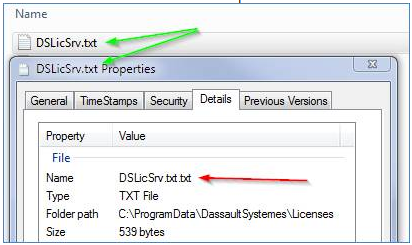Client cannot communicate with server
If this problem occurs:
- On the client, run the DSCheckLS tool to get the results of certain automatic checks.
- Check that client and server have an absolute time difference lower than one hour (whatever the time zones, which are ignored). A warning message Incompatible clock setting can be found in the server log in such a case.
- Check that the
.txtextension is not duplicated for the DSLicSrv.txt file on a Windows client:
This type of issue can occur when your Windows explorer is configured to
Hide extensions for known file types. - Check that the DSLicSrv.txt file is at least in read access for everyone on the client.
- Check that the server is declared in the DSLicSrv.txt file with a full qualified domain name if your network settings require it.
- Check that
the
DSLS_CONFIGenvironment variable has not been set on the client, or has been set to an appropriate value. - Check that the C:\Windows\System32\drivers\etc\hosts file on a Windows client, or /etc/hosts file on a Linux client, does not contain a configuration preventing server access.
- Check that
the license server version is able to serve the client application
version.
A simple rule is that the latest server version should be always
installed, because it's compatible with all existing supported client
application versions.
The latest license server version can be downloaded from here:
https://www.3ds.com/support/documentation/resource-library/single/dassault-systemes-license-server-and-license-keys
- Check that the proxy settings declared in the Windows Internet Options of the Windows client do not prevent server access.
- Check that the client firewall, server firewall, network equipment and security software are properly configured. The TCP (HTTPS) protocol must be allowed from client to server typically on port 4085, or another port number if your server is configured to listen to a non-default port number.